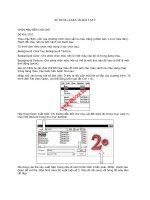Tài liệu Corporate Finance handbook Chapter 2 docx
Bạn đang xem bản rút gọn của tài liệu. Xem và tải ngay bản đầy đủ của tài liệu tại đây (221.06 KB, 42 trang )
Part Two
Debt Finance
2.1
Structured Finance
John Bagley
NMB-Heller
Introduction
Traditionally, corporate finance was the domain of a company’s
bankers, who would lend money for growth by way of overdraft facil-
ities and loans, on the strength of the balance sheet – historic infor-
mation based on the company’s net worth. Now, growing businesses
can take advantage of ‘structured business finance’, which is based on
the value of a company’s assets and is a more flexible source of finance
than bank loans and overdrafts. Structured business finance is based
on the principles of invoice discounting, taking the idea one stage
further by financing other assets.
Invoice discounting is a source of business finance which
advances cash against the value of sales invoices and which allows
the business to run its own sales ledger and payment collection.
Invoice discounting itself developed from ‘factoring’, the form of
invoice finance that involves handing sales ledger administration
over to the finance provider – and paying an administration fee for
this service.
Structured business finance follows the route taken by asset-based
finance in the United States and tends, in the UK, to be offered by
those finance providers not owned by the high street banks. The
product is driven more by asset valuation than by balance sheet
valuation and, as such, is highly attractive to ambitious, expanding
businesses. In general, structured business finance is used by
medium to large SMEs (up to around £60–70 million turnover),
which require a more flexible funding package than can be provided
by mainstream banks.
Strategic structured finance
Increasingly, we are now finding that structured business finance
provides an ideal solution for management buy-outs and buy-ins
(MBOs and MBIs) and other financial restructurings. The more tradi-
tional use of structured business finance has tended to be for busi-
nesses that are highly seasonal – such as those which depend on the
Christmas trade. Generally it is true to say that structured business
finance is far more flexible than the bank overdraft, and levels of
finance available are usually higher. This is because there is no
monetary limit set on borrowing levels, as they are linked to assets
such as stock and sales which are constantly moving. The finance
provided, therefore, is matched to the assets available, not to pre-set
limits. When structured business finance is provided by a company
independent of the high street banks, it will generally tend to replace
traditional bank overdrafts and loans.
In its present form, structured business finance has been in exis-
tence for the past two or three years and is becoming extremely
popular. Although figures are not yet kept separately for this form of
asset-based finance, statistics from the Factors and Discounters
Association show a healthy growth in overall business volumes
within the asset-based finance industry – over the last ten years a
seven-fold growth from £7 billion in 1987 to nearly £50 billion in 1997.
The greatest area of growth, in our experience, is in arranging MBOs
and MBIs. Here, the level of flexibility which structured business
finance provides is highly attractive to the corporate finance team
involved in arranging the overall deal. Structured business finance
can provide a source of finance for the buy-in/buy-out which enables
the new management to retain 100 per cent equity in the business
(rather than hand over a proportion to a venture capitalist) – an
option which comes very high on the list of priorities of the new
owners. The key to structured finance is the funding of invoices
followed by the funding of stock. An agreed percentage is made
available against both of these assets, normally up to 85 per cent
40 Debt Finance
against invoices and 30–50 per cent against stock. Interest costs can
be less than those charged by a bank for an equivalent facility;
however, they will depend on the complexity of the deal and there
are administration fees. It is unlikely that the managers will be asked
to provide guarantees.
Case studies
A couple of examples of structured business finance facilities for
an MBO and MBI recently arranged by NMB-Heller illustrate
how structured business finance works in practice, and how it
can provide solutions to meet needs speedily and effectively.
Frith’s Flexible Packaging Limited
The first shows how this structured finance approach was used
for an MBI in David Watson’s purchase of packaging specialist,
Frith’s Flexible Packaging Limited. Here NMB-Heller teamed
with its associate company, ING Lease, to provide sufficient
cash for the buy-in. David Watson worked with a corporate
finance consultant, first to identify the best business to acquire,
and then to source funding. Because this acquisition was
intended as the first of several, a major objective was to avoid
the need to raise venture capital, holding it in reserve for larger
future deals. To achieve this they needed to find an asset-rich
business for sale, where 100 per cent asset-backed funding could
be raised, and found Friths to be the ideal choice. When it came
to sourcing the funding, ING Lease was prepared to go to 100
per cent funding of the plant and equipment on its appreciation
of the strength of the business plan and the competence of the
incoming MBI leader. NMB-Heller was selected to provide
working capital by way of a term loan and invoice finance,
because NMB and ING Lease could work together to produce a
fast track service, providing a turnkey funding solution that
avoided the need for the client to cede equity to a third party.
There was an ‘agreement in principle’ within 48 hours and the
whole deal was completed from start to finish within three
months.
Structured Finance 41
Eurotec Automotive
The second example shows how Eurotec Automotive, a wholesale
distributor of vehicle parts based in Wakefield, was acquired in a
management buy-out jointly undertaken by the company’s
management team and its major customer from French parent,
the CFAO Group. The business has an increasing turnover of
£8 million, which has grown over recent years from £1 million
under the leadership of managing director, Ron Branton. Integral
to the deal was the asset-based working capital solution put in
place by NMB-Heller which has supported the buy-out team and
allowed it to retain complete equity control over the business. The
management team can now call upon a flexible funding package
that includes working capital advanced against debtors and stock,
a working capital term loan and trade finance to facilitate the
import of goods on letters of credit.
Crucial to the success of the deal was the ability to meet the
tight timeframe set by the company’s original owners for the
completion of the deal. The NMB-Heller support package was
implemented within a six-week period from start to finish, and
enabled the management team to successfully complete the deal
on time. A rival buyer from within the trade had intended to
absorb the business into its own organisation, which would have
resulted in redundancies for Eurotec employees. However, the
NMB-Heller deal has now secured the long-term future of the
business.
Summary
The ideal profile of a company that will benefit from structured
business finance is one that is growing or undergoing a period of
change, with experienced and forward-looking management, where
the net worth of the company is relatively low compared with its
turnover, but the company has good debtors and a fairly large element
of finished stock on its balance sheet. Structured business finance is
built upon the lender’s knowledge of, and confidence in, a particular
business. Timescales will, therefore, have to take into account the
42 Debt Finance
familiarisation process. Before any decision to invest in a company can
be made, the lender needs to understand the business and the
management plans and evaluate the size and strength of the assets –
the invoices, stock and other assets to be funded. Normally, however,
this process should not take more than three to four weeks.
Structured Finance 43
2.2
Asset-based Finance
Forward Trust
How to pay for today’s assets with tomorrow’s money
Funding the cost of growth need not be a headache. A recent Bank of
England report highlighted concerns that many British businesses still
fund the fixed assets they need for growth from overdrafts or even cash
flow. But short or medium-term borrowing to fund long-term
investment can seriously affect businesses’ corporate profitability.
Equally, to use the company’s own capital resources for such purchases
can prove short sighted. Capital safely invested against a rainy day that
produces a solid return is far more useful to the company than money
spent on an asset that will depreciate. Spending these funds on an asset,
even though it may be key to the company’s future, reduces the
company’s working capital which could be better used in many ways –
perhaps buying raw materials, improving wages or paying suppliers.
Using a bank loan or, even worse, an overdraft to fund asset
purchases can be problematic. Interest rates can be unpredictable
when what your business needs is stability in order to plan ahead to
compete. Furthermore, does it make sense to have a loan secured on
an asset that will depreciate as time goes by?
In spite of this, almost two thirds of the capital investment in plant,
machinery, vehicles, ships and aircraft is funded either through cash
flow, bank loans or the capital of the company.
But the balance is changing. Increasingly, businesses are looking
towards asset finance houses to fund capital equipment. The asset
finance idea is well over 60 years old and some finance houses have
been providing both practical advice and capital for development for
many years. Already some £21 billion of assets are financed this way
and the trend, given the tax advantages and the release of capital built
into the systems on offer, is increasing.
Basically, there are two ways to acquire assets this way: leasing and
hire purchase. The difference is as simple as the names suggest. With
leasing you have the use, but not the ownership of the asset, and with
hire purchase, you have the use and the option of ownership at the
end of the term.
The system that is most advantageous for your business will depend
on a number of factors. Every business has its own special needs and
problems, so it is wisest to spend some time discussing your own
circumstances with an asset finance expert, in order to compare
options. All surveys demonstrate that, since tax is tax and interest rates
are interest rates, the key factor in the choice of finance house is almost
always its ability to add value to the financial package, combined with
financial stability.
Nowadays, leasing companies tend to be part of one of the major
banking and financial services groups, and have consequently become
enormously sophisticated, providing advice on a wide range of
subjects, from the tax implications of your decision to the maintenance
contracts you may need for your particular kind of asset. You also need
to look for what added value they can bring, for example:
•
Do they understand your market and the assets you require?
•
Do they know how your business operates?
•
Do they know what customers you have and what assets you own
already?
•
Is ownership necessary or will hiring fulfil your purpose?
•
Will the asset be coming from Britain or abroad?
•
Do you have to pay a deposit?
The questions may seem endless, but there is a practical purpose behind
them. The finance company should be aiming to produce a tailored plan
for your business that takes into account three key factors:
•
What income will be generated by the asset?
•
What is its anticipated working life?
•
What will its value be at the end of the term?
46 Debt Finance
Simply put, the plan they produce should always match the repay-
ments you have to make to the income that the asset will provide for
your business.
So the agreement you enter into, whether it is a lease or hire
purchase, can be tailored to suit your business. Today, some top finance
houses have built up a track record of specialised experience in
particular industries, bringing a particular understanding of the
problems and opportunities facing your industry. This means that they
can frequently point you to the best supplier for the asset you need,
help you to specify the equipment that will suit your business best and
can actually suggest ways of working that may not have occurred to
you. Some companies in your market may even be able to improve or
develop new products or services for you. In addition, if you choose to
lease, the financial muscle of these finance companies often means that
they have considerable buying power, helping you to minimise costs.
Of course, because financial engineering is their core skill, you
should also consider the ingenuity of the finance house. Competition
is such that lessors must always seek to provide a financial package
that makes the most of every opportunity to cover work in your
favour. As well as making the most of your own position, they should
also optimise the way you pay interest. For example, you may imagine
that two per cent over bank rate is the same, whoever the supplier; but
some companies calculate the interest you pay quarterly. So, even
though you may have repaid quite a considerable sum by the end of
the quarter, the interest you are paying is still being calculated on the
amount owing at the start of the period. Ideally, of course, your
interest should be calculated on a day-to-day basis.
The finance period is also important. An experienced finance house
will understand your business and, recognising that some assets have
a longer life-span than others, will advise you what the best timing
should be; usually anything from three to seven years. They should
also recognise that this period may well need to involve the time taken
to set up the equipment – a printing press for example – before it can
begin to produce an income. If this is the case, the company you
choose should be prepared to look at low initial repayments, rising to
the full scale when the machine is operating at peak efficiency. They
should also understand the need for seasonal payment for assets such
as coaches or food processing equipment for a particular crop, and
cars, a subject that interests managers in most companies, are a matter
of much consideration; how many miles, what type of miles, what
Asset-based Finance 47
kind of servicing? These are the kind of details that any business
should consider before pursuing a relationship with a finance house.
But all financing, whether hire purchase or a lease, will offer your
company similar, broad benefits, as well as the particular advantages
offered by individual companies.
First, it allows companies to plan ahead and provide considerable
reassurance for the financial director.
Second, a choice of repayment methods, including fixed rates,
means that you can budget more accurately because all your costs are
pre-determined, not simply in terms of the repayments you make, but,
with contract hire, in terms of the costs of running the asset itself. If, for
example, you have a vehicle that the finance company has arranged to
be kept in good order, you can be sure it will be properly maintained
and that you will have the vital use of that asset for your business. The
maintenance package may be arranged through the finance house or
even through the manufacturer of the asset itself. Cars, for example,
would be covered by the finance company, but heavy manufacturing
machinery could well be the subject of an agreement made between
the finance house and the manufacturer, to keep the asset in good
running order for you. Once again, the finance house should tailor the
most suitable package for your company.
Third, your financing costs can be fixed. At the start of the agreement,
you agree with the finance house the period of the agreement, the
repayments that are necessary, and the rates you will have to pay.
Fourth, and possibly most reassuringly, this route is increasingly
proving to be the best way to use a company’s resources. Because it frees
up your cash flow as well as your capital, asset finance can actually help
your company grow. It is becoming an important part of the overall
strategic plan for a great many companies; and, as its effectiveness is
proved, it is increasingly being built into a company’s strategy, rather
than simply being used on an ad hoc basis. It puts your own money to
work, doing what it should do: supporting your business.
You can also benefit from considerable tax advantages when using
both leasing and hire purchase. Before outlining the major benefits of
these, it is sensible to consider the basic question: do you need to own
the asset eventually or do you simply need to have the use of it for a
certain period of time?
Though the finance house will usually help you decide the answer
to this question and will provide useful pointers, it is worth outlining
the advantages of the two main routes.
48 Debt Finance
Hire purchase
Hire purchase is a system whereby you pay a specified amount of
money over a pre-determined period. At the end of the agreement,
you pay the option to purchase fee that can be arranged to suit your
business’ financial situation. If ownership is really important to your
company, this is the way to go.
The particular tax advantages it offers are that, although the asset
does not belong to you until the end of the term, you can claim a tax
deduction on all the interest paid against your profit and loss account.
The other advantage is that you can claim the capital allowance, so a
percentage of the cost of the asset can be offset against the tax you
have to pay.
In addition, if your business is VATable, you can claim all the VAT
paid on the asset as if you had bought it outright. The only exception
to this rule is in the case of cars, which are regarded by the Inland
Revenue as a separate case.
In all these three cases, the tax rights of ownership belong to your
company, although the asset is actually owned by the finance house.
This is called ‘deemed belonging’.
As you are treated as the owner as far as tax and accounting are
concerned, you can also claim depreciation in your books. As far as the
Inland Revenue is concerned, there is no difference between an asset
that is yours under a hire purchase agreement and one that you own
outright. It is dealt with in just the same way as any other fixed asset.
Leasing
There are two forms of leasing: Finance Leasing and Operating
Leasing. The decision to go the leasing route is also a matter for
discussion with the finance house and your business advisers. You
might, for example, prefer to lease if you cannot claim your capital
allowance due to lack of profits. If this is the case, you can benefit
from the tax allowances that the finance house can claim, as they will
pass them on to you in the form of lower repayments. Or perhaps the
way that you look at a discounted cash flow in your business might
make it more financially viable to lease; and, of course, it is possible
for a lease to be off balance sheet. There are many reasons you might
consider.
Asset-based Finance 49
Finance leases
Finance leasing is on balance sheet, and operating leasing is off balance
sheet, and there are strict rules governing which of the two you can
have. A finance lease is simply described as one where all the risks and
rewards are transferred to the lessee. If you have benefited from all the
tax benefits during the contract and, when the asset is sold by the
finance house at the end of the lease, you receive some of the sale
proceeds, then you have effectively received the benefits of the asset.
Under a finance lease, the sale of the asset is carried out by the lessee,
operating as the agent of the finance company. The money from the
sale goes to the finance house, but they return up to 95 per cent of it to
the client. So the client never actually owns the asset, rather it is seen as
being loaned to the client and so should be shown on your balance
sheet.
The other benefits are that the rental interest can be variable. Again,
this is part of the risk and reward factor. If the bank rate falls, you will
benefit; if it rises, you will have to pay more. That is a risk calculation
you alone can make.
With a finance leasing agreement you don’t pay VAT on the capital
cost. But VAT is charged on the rental and you can recover the VAT
paid. The leasing rental is classified as a revenue expense.
At the moment, finance leasing volumes are falling off, as companies
look to other, less complex forms of leasing and because recent legis-
lation has removed some of the tax advantages they once enjoyed.
Operating leases
An operating lease, with or without maintenance, appears off your
balance sheet because most of the rewards and all the risks lie with the
finance house.
The way it works is simple. The finance house will discuss the
asset you need in just the same detail as with any other contract. In
this instance, they will be seeking to find the exact use that you will
put the asset to so that they can calculate what its value will be at the
end of the term. This is called the residual risk. The finance house is
using its experience to determine the value of the asset when the
contract is over. The reason is that the repayments you make will be
based on the difference between the purchase price and the amount
they believe that they can sell the asset for when you have finished
with it.
50 Debt Finance
Suppose that you are buying a vehicle – say an HGV and trailer.
The finance house will want to know all about your business, the
loads you carry, journey times and distances, the qualifications of
those driving, where the vehicle will be stored and how it will be
maintained. With this knowledge they will decide its value in seven
years’ time, the period you have decided that you want the use of the
vehicle for. You will make regular payments on the pre-determined
value of the asset for this period – not the whole life. As a result you
will pay a lower rental. Another consideration will be the mainte-
nance of the vehicle to ensure it is to the standard required to achieve
its predicted value at the end of your agreement, although this will
form part of your contractual negotiations, as maintenance is one of
the added value services many finance houses offer as part of their
packaging.
You will also benefit from the fact that the finance house, because
it actually owns the asset and has taken the risk of forecasting its
value, will be able to claim the capital allowance on it and so will be
able to charge a lower rental than might otherwise be the case. For
hauliers who are non-tax-payers, this reduction can be particularly
useful. Your company can also charge the cost of the rental against
its corporation tax and, of course, your financial director will be
delighted that the payments will remain predictable and that there
is no question of any risk in estimating the re-sale value at the end of
the term.
The only variation to these general rules applies to cars. Because
they are regarded by the Treasury as part perk and part company
necessity, they are assessed differently. As a result, you cannot
deduct the rental costs against your corporation tax unless the car
itself cost less than £12,000. In the case of cars, it is always sensible to
discuss the exact use of your fleet with an experienced finance
house as they can advise on the most tax efficient route, the timing
involved and the maintenance package that will suit you best.
Contract hire is also one of the best ways to remove a lot of the
problems of maintaining your car fleet from the shoulders of your
fleet manager.
The popularity of this method of asset financing is growing rapidly,
partly because of its simplicity and the increasing trend to out-
sourcing, and partly because the alternative route of finance leasing
has become less attractive as the tax benefits have been reduced by
successive governments.
Asset-based Finance 51
52 Debt Finance
In fact, so popular has contract hire become that some of the largest
deals in the past few years have been on this basis. Planes and boats
and trains, the big ticket assets, are very frequently financed in this
way and clients have seen enormous benefits.
Case study
ScotRail
In a recent transaction with ScotRail, the client was able to afford
to lease 40 trains when they had only expected to be able to lease
38. This was due partly to the construction of the financing and
partly to the sheer financial muscle of Forward Trust Rail being a
member of HSBC.
‘Our buying power and strength in the marketplace enabled us
to use the economies of scale in our negotiations with the rolling
stock manufacturers,’ said Peter Aldridge of Forward Trust Rail.
This particular transaction began with detailed discussions
between Forward Trust Rail and ScotRail itself. If a financier is to
provide the best results for the client, a detailed picture of every
part of the customer’s objectives needs to be established. Only
when this is complete can a realistic proposal be made. The
timing, specification and structure of the bid between Forward
Trust and ScotRail were all ironed out prior to discussions with
potential manufacturers. ScotRail specifically requested that the
financiers give their best price in the tender response rather than
getting involved in long, drawn-out haggling at a later date.
Time was of the essence throughout the transaction and was
exacerbated by the fact that, as a result of a franchise commitment,
ScotRail needed to have the rolling stock in service by March 2000.
At the appointment of Forward Trust Rail, the two parties set
about creating a detailed specification for the trains which was
given to three manufacturers for tender.
‘We had negotiated some 95 per cent of the contents of the lease
with ScotRail before we even spoke to the manufacturer,’ said
Peter. At the same time, Forward Trust Rail negotiated both a
spares and maintenance agreement with the manufacturers. Two
of the 50 engineers who work for Forward Trust Rail were
employed at this stage, as their expertise was vital. Forward Trust
Asset-based Finance 53
aims to work in partnership with its customers, providing a port-
folio of services and knowledge in addition to finance.
The lease agreement does not require ScotRail to make
payments while the trains are being built. However, Forward
Trust Rail has already started paying the manufacturers in stages,
with the largest payments made on delivery of the rolling stock.
To protect and support the interests of both parties during the
building process, four engineers from Forward Trust are working
with ScotRail.
The finance house should always aim to make the purchase and use of
the assets required to run your business as simple and as painless as
possible. To do this:
•
They need to have access to considerable financial strength because
you want to be sure that they will continue to back you throughout
the whole term of the contact.
•
They should be independent. By not being tied to any one manufac-
turer, they will be able to shop around on your behalf and make the
best buys for you.
•
They should be able to offer you the benefits of buying in bulk that
will serve to lower your costs.
•
They should have the depth of expertise to be able to offer you more
than just money.
•
They should understand your business and the market you operate
in. This will allow them not only to tell you where the best place to
buy tyres can be found, but to advise you on market trends that
might affect the way you run your own business.
As in so many financial markets today, it is the added value that
counts; the service that goes with the cash should be the most
important factor in your decision about which finance house to choose
and which system will suit you best.
All reasonable care has been taken in the preparation of this
article, but it is intended only to be a general guide. You should
check the position of your own company, with regard to financing
assets in this way, with a professional financial adviser; the
treatment of leases, for example, can vary depending on an
individual auditor’s interpretation. You should also make certain
that there have not been any fundamental changes in accounting,
taxation or legal requirements.
Extract from Bank of England ‘Finance for Small Firms – An Eighth
Report’ (March 2001)
The Finance and Leasing Association (FLA) is the major UK representative
organisation for the asset-based finance industry, accounting for approxi-
mately 90% of the sector. In February 2001 the association had 95 full
members and 71 associate members, drawn from high street banks’
subsidiaries, merchant banks, building societies, leading finance houses,
leasing companies and the finance sections of manufacturing and retail
companies. Business finance excluding big-ticket items (defined as a finance
facility of greater than or equal to £20 million for a single project) has grown
consistently, to around 19.1 billion in 1999.
SMEs account for a significant proportion of FLA business. Firms with a
turnover of less than £5 million accounted for 58% of new business in 1999.
Furthermore, nearly £7 billion (30% of new business) went to firms with an
annual turnover of less than £1 million. The FLA believes that asset finance
provides the products that allow SMEs to grow, right through the size
spectrum – from leasing a single computer to using asset finance in the run-up
to flotation. The FLA is currently campaigning for the removal of the exclusion
of leased assets from enhanced fiscal depreciation for SME. Owner-users of
plant and equipment, who satisfy the conditions on corporate size, can
generally claim a first-year allowance of 40%, but if they lease the assets, the
lessor can claim 25% writing-down allowances.
54 Debt Finance









